Step by Step Guide of How to use Paris Metro
How to use Paris Metro? Don’t get lost in front of the ticket machine or the metro map. Learn how to use the metro and find the right direction. Follow this guide to get your Paris weekend amazing. Guide written by a french native.
To make the most of your time in Paris, make sure you read our Paris guide of what to do and where to stay.
History of the Paris Metro
With 205 km of lines, 303 stations and over 1.5 billion passengers carried each year, the Paris Metro is one of the world’s most effective underground systems. However, the current systems is the result of a long history and is thanks to one man: Fulgence Bienvenue.
Amid the industrial revolution, the Second Empire attempted to modernize the Paris by building railroads. The “line of the small belt”, a twofold track encompassing Paris was constructed in 1852 but did not solve the issue of transport inside this circle.

Paris Metro map in 1900
In 1863, London agreed to the world’s first underground railway, followed by New York in 1868, Chicago in 1892 and Budapest in 1896. Eventually, after years of discussion between central government and the City of Paris, it was decided in 1895 to build an urban transport system in Paris. There were two main objectives. Firstly, to open in time for the 1900 World Fair and, secondly, to have 6 lines built before 1911.
This task fell to a Breton engineer of bridges, Fulgence Bienvenue, who was born in 1852 and lost his left arm in 1881 from an accident at work. This did not stop him from climbing the ranks until he became Chief of Technical Service of the Metropolitan in 1898.
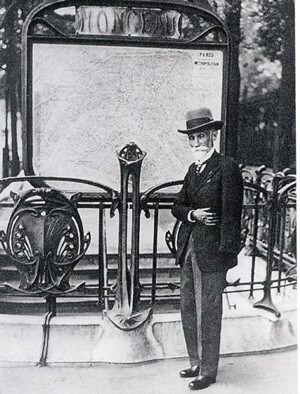
The construction of the Parisian Metro was an important achievement in the 20th Century and brought Paris in line with London and New York. However, in addition to the works causing enormous changes to the city, Parisians were also outraged by the development.
Despite being almost completed, the World Fair opened on 14 April 1900 without a Metro. Shortly afterwards, on 19 July 1900, Line 1 which joined Porte Maillot and Porte de Vincennes became operational. This was just the beginning of a long history but was quickly successful. In just 5 months, 4 million travellers used this section of the Paris Metro. Later, lines 2, 3, 4, 5 followed and the work was completed in 1910, a year ahead of schedule.

Fulgence Bienvenue was responsible for the overall construction of the Metro until 1932 except for Lines 11 and 14. Fulgence Bienvenüe is buried at Père-Lachaise Cemetery.
How the metro works ?
Today, the Metro has 16 lines. You can visit all the famous attractions in Paris by Metro. For example, if you take Line 1, you can see le Quartier du Marais, le Chatelet-les-Halles, le Louvre, les Champs-Elysees, and l’Arc-de-Triomphe. If you want to go to the Eiffel tower, you need to use Line number 6. For Notre-Dame de Paris and Saint-Germain-des-Pres, you need to use Line 4. Check out the map. The Metro opening times are from 05:30 unti 01:15 (the Metro is closed between 01:15 and 05:30). To travel between these times, you can use the Noctilien bus (night bus).
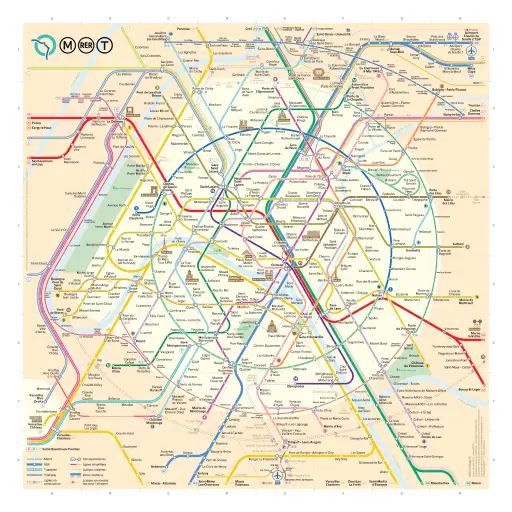
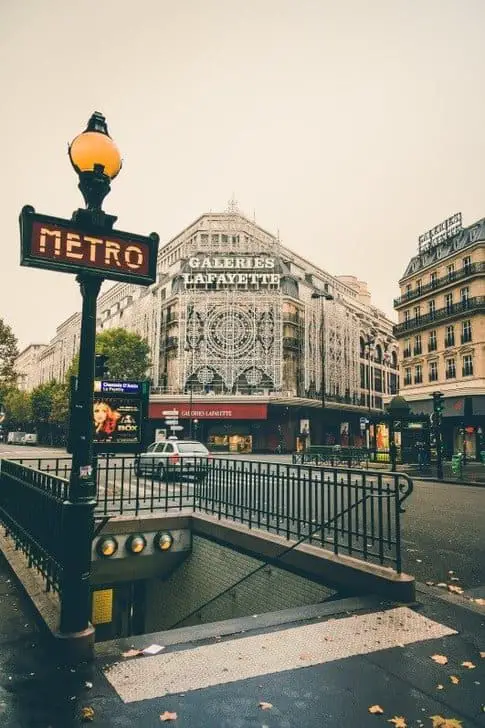
The Paris Metro also has different Zones; the centre of Paris covers Zones 1 to 3 and the airport is Zones 4 and 5.
There are different style of entrance but they all go down.
For useful tips regarding Paris Metro safety, make sure you read our essential guide.
How to buy a ticket ?
How to use Paris Metro? There are different types of ticket. A single ticket is for one way and you can stay inside the Metro for 2 hours. Buy a book of 10 (un carnet) and you will save money. If you are doing more than 4 journeys during a day, it is better to buy ‘le ticket mobilis’ which is valid for one day. The price depends of the Zone but if you want to visit the centre of Paris, this ticket costs approximately 8 euros. If you want even more flexibility, you can buy a ‘forfeit Paris visite’ and with this ticket you can travel and receive discounts on attractions such as 20% off a visit to l’Arc de Triomphe and some other museums. Also, ticket machines can vary – some take bank notes and coins, most take coins, all take cards – but only chip and pin cards. Kids under 4 can travel free.
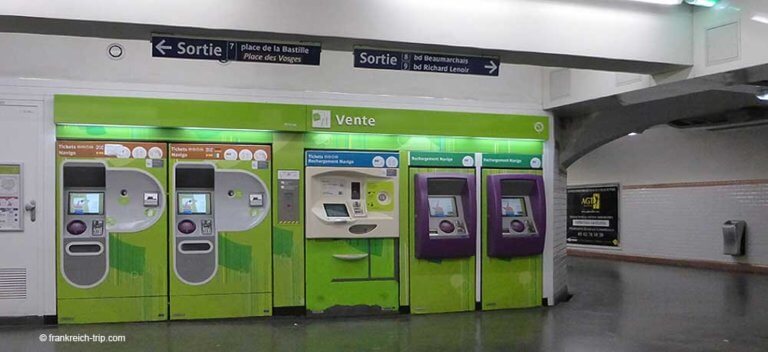

When you have your ticket, you need to choose where you want to go. Be careful because the lines are numerous and go in various directions. You don’t take the 2 “west” or “east” but in the direction of the endpoints (i.e. “Étoile” or “Nation”). So, you should always be aware of where your line ends to catch the train in the right direction.
When you know where you want to go, insert your ticket inside the gate. Afterwards, you can access the platform, so check again the name of the end of the line to know if you are heading in the right direction or not.
Whilst you stay inside the Metro, you won’t need to use another ticket. Your ticket will be valid for 2 hours. So, if you are going the wrong way you have time to change platform at the next station.
How to use Paris Metro the map? At the station, always find a map which shows the different exits. Take 5 minutes to look where exactly you want to go and use the right exit.
If you need to change line, you need to follow the sign with the colour and the number of the next line.
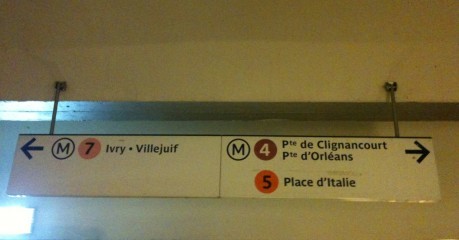
If you are disabled, it will be difficult for you to use the Metro. For now, only line 14 is accessible by wheelchair users.
Difference between Metro and RER
How to use Paris Metro RER? In addition to the Metro, you can also find the RER. The RER travels outside of Paris, but you can also use it inside Paris. However, you need to check on the map where the RER stops because it doesn’t stop everywhere. The RER is a double-decker train and much bigger than a Metro train.
Interesting Metro stations
Interestingly, there are many Metro stations which are worth visiting. For example:
Louvre-Rivoli
The Louvre stands out amongst the mainstream attractions in Paris because of its tremendous collection of works of art. Receiving more than 9 million guests per year, it’s not surprising then that the Paris underground needed to mirror the style and stature of this prestigious historical centre. This Metro station was built in 1990 at the same time as the glass pyramid was erected in front of the Louvre museum. The Louvre-Rivoli Metro station was designed with reproductions of fine arts to echo the pieces inside the historical centre itself.
Although this Metro station does not grant access to the Louvre museum itself, visitors travelling past on Paris transport can enjoy the pieces on display. The Palais Royal-Musee du Louvre is the Louvre Museum’s main Metro station now and is another must-see on your list of interesting Metro stations to visit. Also, the Place Colette Metro entrance is made from multi-coloured glass baubles and is definitely worth a look.

Concorde
Concorde is one of the enormous intersections in the Paris underground, connecting Lines 1, 8 and 12. It’s the main station to head towards if you’re heading to the Orangerie Museum or taking a stroll up the Champs-Elysées. Opened in 1990, it stands out amongst the most unique stations in Paris thanks to the walls of Line 12 which are adorned with lettered tiles.
These lettered tiles spell out the 1789 Déclaration des Droits de l’Homme et du Citoyen and were designed by artist Françoise Schein. Whilst you wait for your train, see how many words you can spot! What’s more, Ezra Pound’s 1912 poem entitled ‘In a Station in the Metro’ was inspired by this Metro station.

Abbesses
The entrance to the Abesses Metro station has one of only two original nouveau glass canopies (or édicules) remaining in Paris. This was built by Hector Guimard and the entrance used to cover the Metro at the Hôtel de Ville before it was moved in the 1970s to the area of Montmartre, home to the Sacré Coeur. If you are a film fanatic, you may also recognise the station from the popular film, Amelie. Abbesses is 36 m deep and is the deepest Metro station of Paris. As you descend the stairs, you will see vivid murals and graffiti-covered walls.

Pont Neuf
Pont Neuf is the oldest bridge in Paris, despite ‘neuf’ in its name which suggests it is new! It was built in 1607 and is popular amongst visitors taking a romantic walk over the River Seine towards the Île de la Cité to visit Notre-Dame and Sainte-Chapelle. The subect of the Pont Neuf Paris underground station is the Monnaie de Paris (Paris Mint) which is situated around the corner. On the walls, you will see large models of French coins, plus various display cabinets and weighing scales for money.
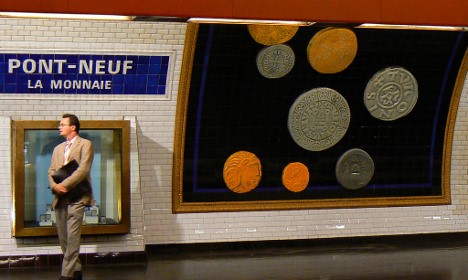
Bastille
Venture back in time and absorb some French history at Bastille station. The walls were decorated in 1989 by Liliane Belembert and Odile Jacquot to celebrate the bicentenary of the French Revolution. From the platform, you can view five frescoes which portray historic scenes.

Arts et Metiers
This Metro station is completely unique, as it’s vaulted and clad totally in copper. The Arts et Metiers station was created to give the feeling of being in a submarine and has portholes and exposed rivets. The Arts et Metiers museum (Art and Crafts) itself contains interesting displays of technological evolution, including old cars and planes, and additionally Foucault’s pendulum.
The re-vamp of the Arts et Metiers station was based on the writing of Jules Verne and reflects the museum accurately and provides an apt entrance of the world of innovation.
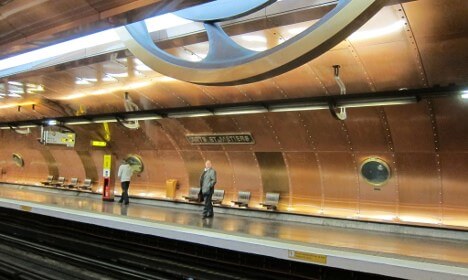
For useful travel accessories to make you feel secure and keep you safe when using the Paris Metro, check out the products which work for us.
How to get to the airport ?
Charles de Gaulle Airport (CGD)
Located 25km to the north-east of Paris and also known as Roissy Airport, Charles de Gaulle Airport is the largest in France and the seventh-busiest in the world, serving more than 65 million passengers a year.
One of the quickest and cheapest ways to travel into the centre of Paris is by the RER B (blue) train line that has station stops at both Terminal 2 and Terminal 3 of the airport. (Note Terminal 2 has seven sub-terminals, but all sub-terminals can be accessed by foot or via the free N1, N2 and N3 shuttle buses). If you arrive in Terminal 1, take the free shuttle train to Terminal 3, which is the easiest station to catch the RER B from.
You can buy train tickets from one of the blue ticket machines (not the yellow machines, which sell TGV tickets only) or from a train station employee in a booth. Tickets cost 9.25€ one-way and the journey takes up to 50 minutes.
Make sure you take the RER B line heading in the direction of Robinson, Antony or St-Rémy-lès-Chevreuse and the train will stop in central Paris stations such as Gare du Nord. Trains run from Charles de Gaulle Airport to Paris between 04:46 and 23:56 Monday to Sunday.
Orly Airport
RER Line B
Orly Airport is connected to the RER B train line at Antony train station by the OrlyVal shuttle train (see below).
Line B of the RER also interconnects with the Paris Métro. Tickets for the Métro (and local RATP buses) can be bought individually or in packs of ten (un carnet), which is cheaper. If you are staying in Paris for more than a day, think about getting a Paris Visite card or a pack. The first one gives you unlimited travel on most modes of transport as well as discounts at museums and other attractions.
OrlyVal
OrlyVal is an automatic light Metro that has only 3 stops: Antony Train Station and two at Orly Airport. Is the fastest way to connect from Orly Airport to any means of public transport, such as RER B line.
- Stops at Orly airport
- Paris – Orly airport South (terminal S): entrance K.
- Paris – Orly airport West (terminal W): entrance A Arrival Level
- OrlyVal is free to use between both terminals, west (W) and south (S).
- Travel Time: 25-35 minutes. The trains operate every four to seven minutes.
- Opening hours: Daily, from 06:00 am to 11:35 pm.
- Fare: €13.25 (RER+OrlyVal).
RER Line C
- A shuttle “Go C Paris” connects Orly Airport to the RER C train at Pont de Rungis- Aeroport d’Orly
- Stops at Orly airport:
- Paris – Orly South: Gate C, Stop 5.
- Paris – Orly West: Gate C, Stop 7
- Travel Time: 35 minutes. It has a frequency of 15 minutes. Fare: €6.35
How to go to Disneyland Paris ?
Disneyland Paris, of Euro Disney, is about 20 miles (32kms) to the east of the centre of Paris. The most popular way to travel between Euro Disney and the city centre is on the suburban commuter trains called the RER (Regional Express Network).
Line A of the RER system terminates at Marne-la-Valee station which is next to the front gates of Disney Village and the theme parks at Disneyland Paris. The journey takes about 40 minutes.


2 comments
This was super helpful! I’m planning my trip and found this to be a great source for things I didn’t even think to consider. Thank you!
Hello – We are so glad you found our article helpful! We hope you have a great visit to Paris and stay safe. Don’t forget your mask!
Comments are closed.